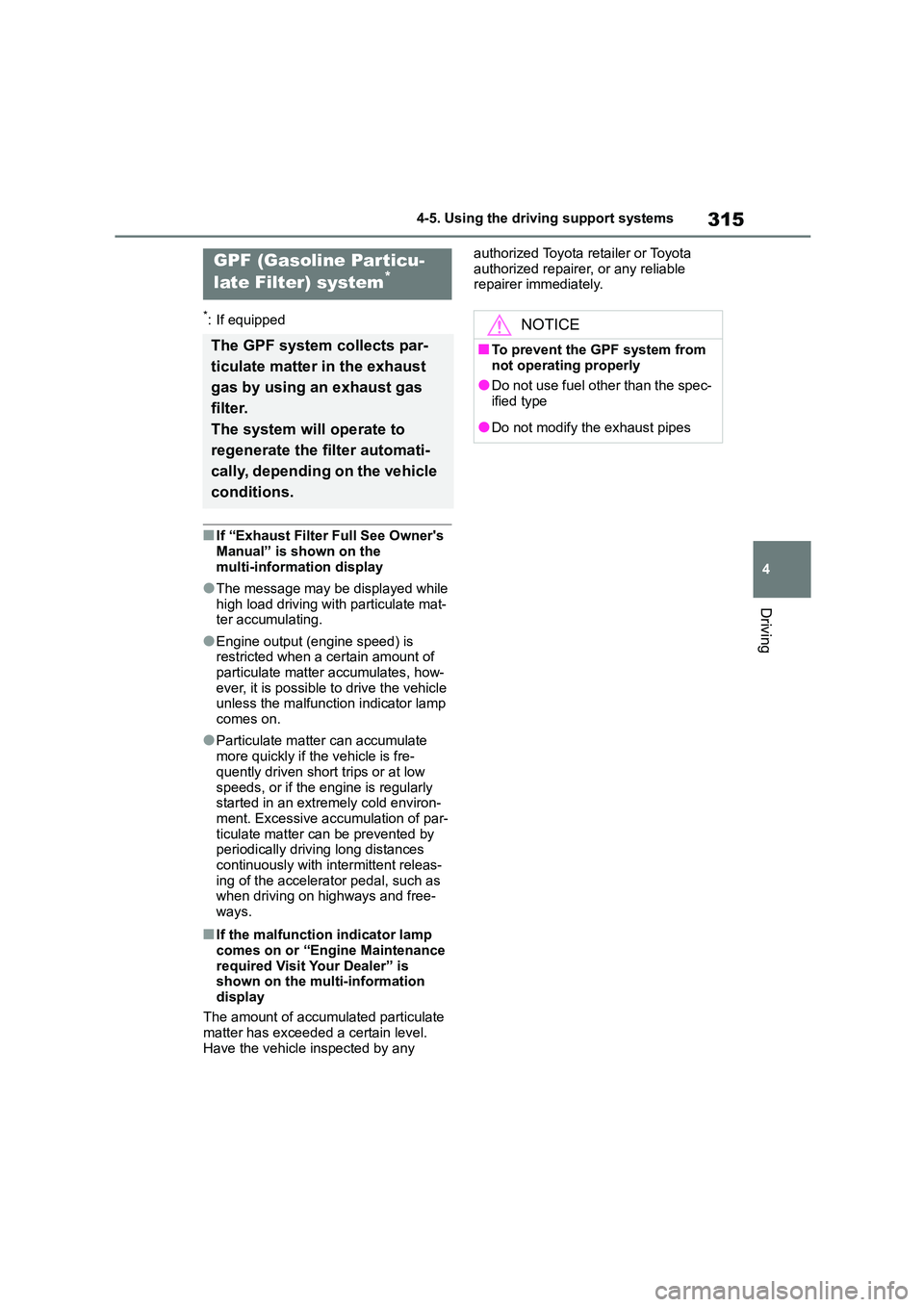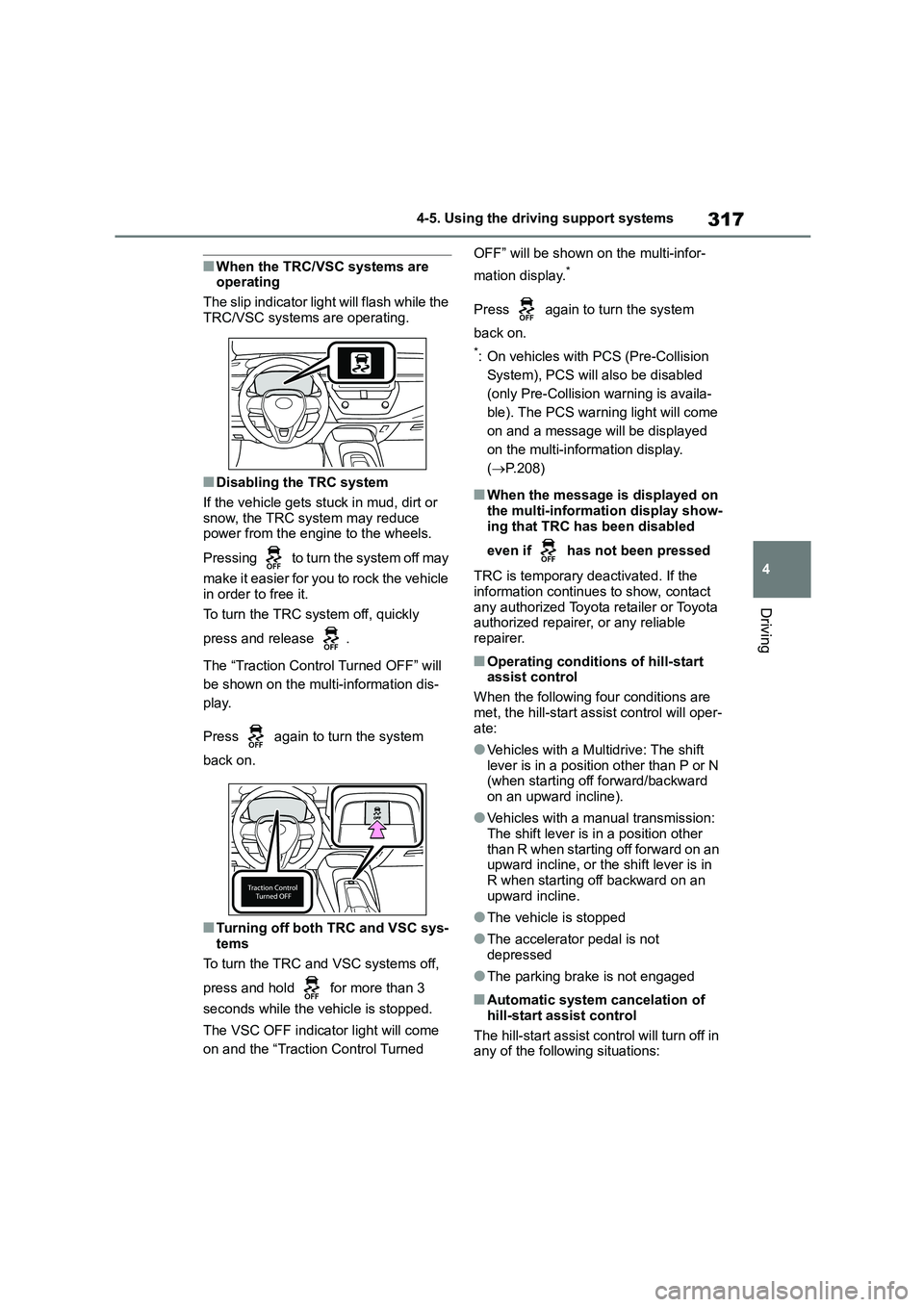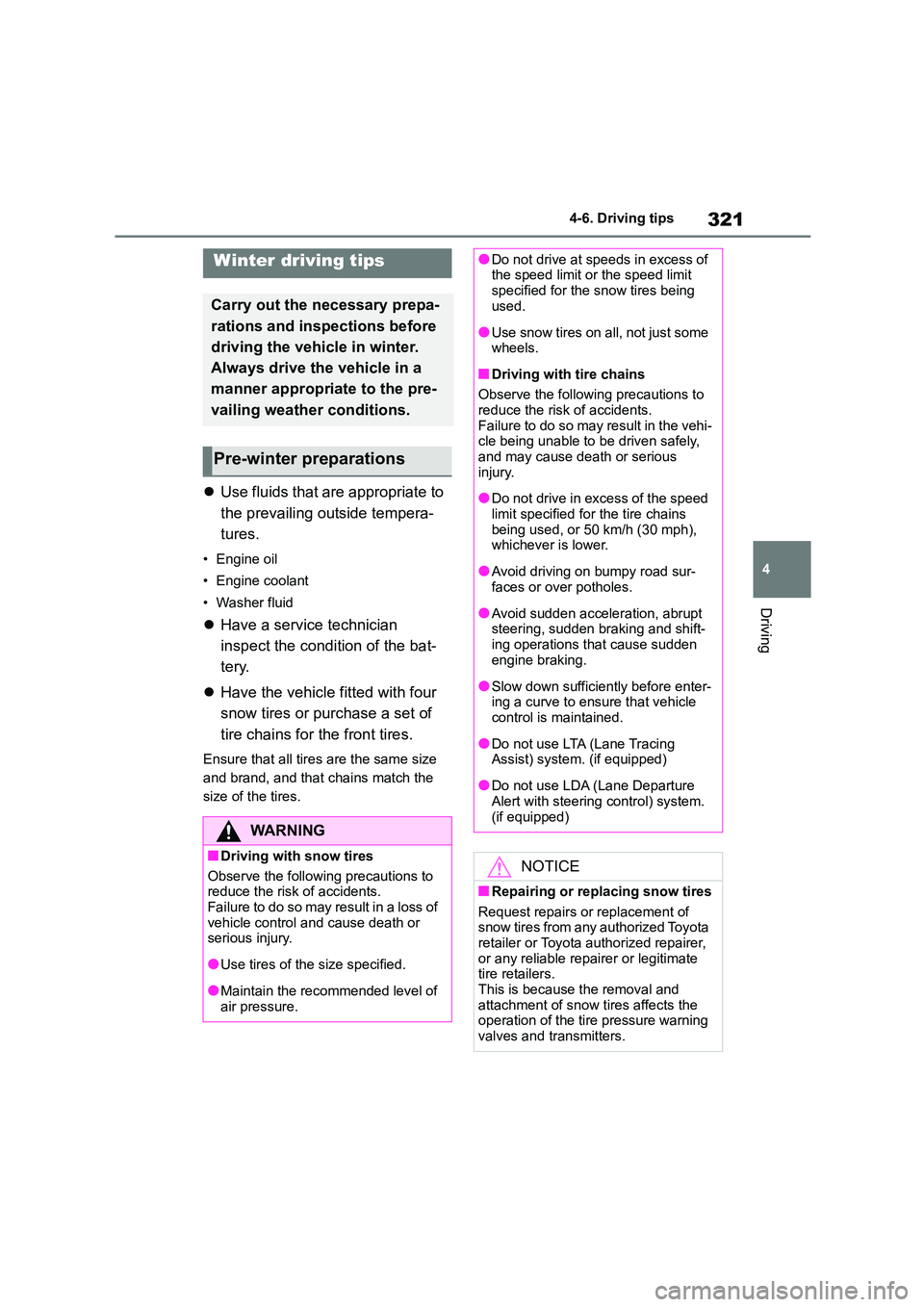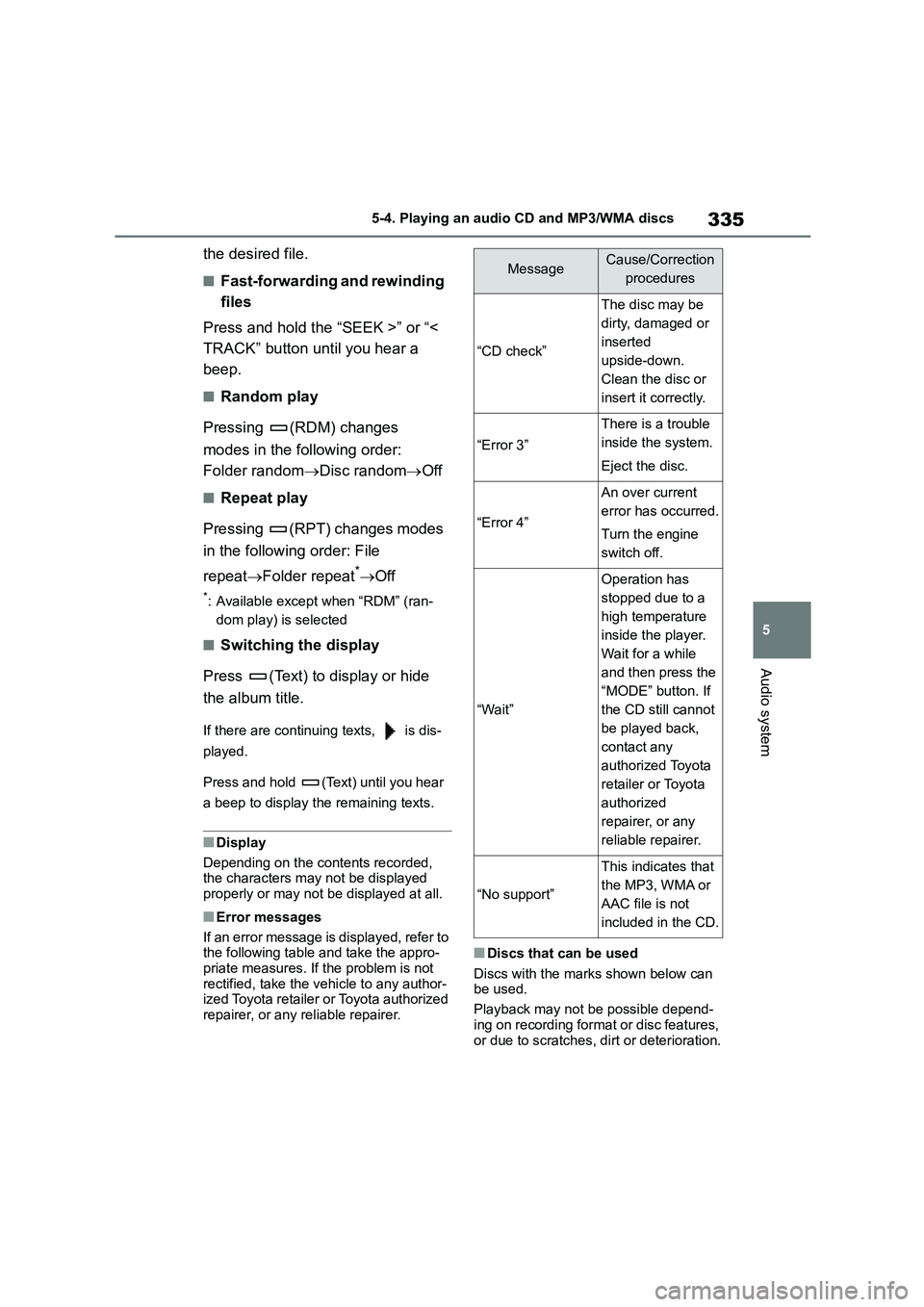2022 TOYOTA COROLLA engine
[x] Cancel search: enginePage 315 of 678

313
4
4-5. Using the driving support systems
Driving
WA R N I N G
●Make sure to observe the following
precautions regarding the exit par-
allel parking assist mode. Exit parallel parking assist mode is
a function used when departing
from a parallel parking spot. How- ever, this function may not be usa-
ble if obstacles or people are
detected in front of the vehicle. Only
use this function when departing from a parallel parking spot. In the
event that the steering control oper-
ates, either turn the system off using the S-IPA switch or operate
the steering wheel to stop the con-
trol.
●If exit parallel parking assist mode
is mistakenly used in the following situations, the vehicle may make
contact with an obstacle.
The departure function is operated in a direction where an obstacle is
present, but the obstacle is not
detected by the side sensors (situa- tions such as when the vehicle is
directly beside a pole).
●Observe the following precautions,
as the sensors may stop function-
ing properly which may lead to an accident.
• Do not subject the sensor to strong
shocks by hitting it, etc. The sen- sors may not function properly.
• When using a high-pressure washer to wash the vehicle, do not
spray water directly on the sensors.
Equipment may not function prop- erly if subjected to an impact from
strong water pressure. If the vehicle
bumper strikes something, equip- ment may not operate properly due
to a sensor malfunction. Have the
vehicle inspected at any authorized Toyota retailer or Toyota authorized
repairer, or any reliable repairer.
●In the following situations, the sen- sors may not operate normally and
may lead to an accident. Drive
carefully.
• Obstacles cannot be detected in
the side areas until a scan of the
side areas is completed. (P.265)
• Even after the scan of the side
areas is completed, obstacles such as other vehicles, people or ani-
mals that approach from the sides
cannot be detected.
• The sensor is frozen (if it thaws, the
system returns to normal). A warning message may display at
particularly low temperatures due to
the sensor freezing and it may not detect parked vehicles.
• The sensor is blocked by some- one’s hand.
• The vehicle is tilted a large amount.
• The temperature is extremely hot or
cold.
• The vehicle is driven on undulating
roads, slopes, gravel roads, in areas with tall grass, etc.
• An ultrasonic wave source is nearby, such as the horn or sensors
of another vehicle, a motorcycle
engine or the air brake of a large vehicle.
• Heavy rain or a water strikes the vehicle.
• The angle of the sensor may be deviated when assist control starts
even if there is a parked vehicle in
the target parking spot. Have the
vehicle inspected at any authorized Toyota retailer or Toyota authorized
repairer, or any reliable repairer.
• Do not install any accessories
within the sensor detection range.
Page 316 of 678

3144-5. Using the driving support systems
*: If equipped
Each time the switch is pressed, the
system changes betw een sport mode
and normal mode.
1 Normal mode
Provides an optimal balance of fuel
economy, quietness, and dynamic per-
formance. Suitable for normal driving.
2 Sport mode
Controls the transmission and engine to
provide quick, powerful acceleration.
This mode also changes the steering
feel, making it suitable for when agile
driving response is desired, such as
when driving on roads with many
curves.
When sport mode is selected, sport
mode indicator comes on.
■Automatic deactivation of sport
mode
If the engine switch is turned off after
driving in sport mode, the drive mode
will be changed to normal mode.Driving mode select
switch*
The driving modes can be
selected to suit driving condi-
tion.
Selecting a drive mode
Page 317 of 678

315
4
4-5. Using the driving support systems
Driving
*: If equipped
■If “Exhaust Filter Full See Owner's
Manual” is shown on the
multi-information display
●The message may be displayed while
high load driving with particulate mat- ter accumulating.
●Engine output (engine speed) is restricted when a certain amount of
particulate matter accumulates, how-
ever, it is possible to drive the vehicle unless the malfunction indicator lamp
comes on.
●Particulate matter can accumulate
more quickly if the vehicle is fre-
quently driven short trips or at low
speeds, or if the engine is regularly started in an extremely cold environ-
ment. Excessive accumulation of par-
ticulate matter can be prevented by periodically driving long distances
continuously with intermittent releas-
ing of the accelerator pedal, such as when driving on highways and free-
ways.
■If the malfunction indicator lamp
comes on or “Engine Maintenance required Visit Your Dealer” is
shown on the multi-information
display
The amount of accumulated particulate
matter has exceeded a certain level.
Have the vehicle inspected by any
authorized Toyota retailer or Toyota
authorized repairer, or any reliable repairer immediately.
GPF (Gasoline Particu-
late Filter) system*
The GPF system collects par-
ticulate matter in the exhaust
gas by using an exhaust gas
filter.
The system will operate to
regenerate the filter automati-
cally, depending on the vehicle
conditions.
NOTICE
■To prevent the GPF system from
not operating properly
●Do not use fuel other than the spec-
ified type
●Do not modify the exhaust pipes
Page 319 of 678

317
4
4-5. Using the driving support systems
Driving
■When the TRC/VSC systems are operating
The slip indicator light will flash while the
TRC/VSC systems are operating.
■Disabling the TRC system
If the vehicle gets stuck in mud, dirt or snow, the TRC system may reduce
power from the engine to the wheels.
Pressing to turn the system off may
make it easier for you to rock the vehicle
in order to free it.
To turn the TRC system off, quickly
press and release .
The “Traction Control Turned OFF” will
be shown on the multi-information dis-
play.
Press again to turn the system
back on.
■Turning off both TRC and VSC sys-
tems
To turn the TRC and VSC systems off,
press and hold for more than 3
seconds while the vehicle is stopped.
The VSC OFF indicator light will come
on and the “Traction Control Turned
OFF” will be shown on the multi-infor-
mation display.*
Press again to turn the system
back on.
*: On vehicles with PCS (Pre-Collision
System), PCS will also be disabled
(only Pre-Collision warning is availa-
ble). The PCS warning light will come
on and a message will be displayed
on the multi-information display.
( P.208)
■When the message is displayed on
the multi-information display show-
ing that TRC has been disabled
even if has not been pressed
TRC is temporary deactivated. If the
information continues to show, contact any authorized Toyota retailer or Toyota
authorized repairer, or any reliable
repairer.
■Operating conditions of hill-start assist control
When the following four conditions are
met, the hill-start assist control will oper- ate:
●Vehicles with a Multidrive: The shift lever is in a position other than P or N
(when starting off forward/backward
on an upward incline).
●Vehicles with a manual transmission:
The shift lever is in a position other than R when starting off forward on an
upward incline, or the shift lever is in
R when starting off backward on an upward incline.
●The vehicle is stopped
●The accelerator pedal is not
depressed
●The parking brake is not engaged
■Automatic system cancelation of
hill-start assist control
The hill-start assist control will turn off in any of the following situations:
Page 320 of 678

3184-5. Using the driving support systems
●Vehicles with a Multidrive: The shift
lever is shifted to P or N.
●Vehicles with a manual transmission:
The shift lever is shifted to R when starting off forward on an upward
incline, or the shift lever is shifted to
other than R when starting off back- ward on an upward incline.
●The accelerator pedal is depressed
●The parking brake is engaged
●2 seconds at maximum elapsed after
the brake pedal is released
■Sounds and vibrations caused by
the ABS, brake assist, VSC, TRC and hill-start assist control sys-
tems
●A sound may be heard from the
engine compartment when the brake
pedal is depressed repeatedly, when the engine is started or just after the
vehicle begins to move. This sound
does not indicate that a malfunction has occurred in any of these systems.
●Any of the following conditions may occur when the above systems are
operating. None of these indicates
that a malfunction has occurred. • Vibrations may be felt through the
vehicle body and steering.
• A motor sound may be heard also after the vehicle comes to a stop.
• The brake pedal may pulsate slightly
after the ABS is activated. • The brake pedal may move down
slightly after the ABS is activated.
■Active Cornering Assist operation
sounds and vibrations
When the Active Cornering Assist is
operated, operation sounds and vibra-
tions may be generated from the brake
system, but this is not a malfunction.
■EPS operation sound
When the steering wheel is operated, a
motor sound (whirring sound) may be
heard. This does not indicate a malfunc- tion.
■Automatic reactivation of TRC and
VSC systems
After turning the TRC and VSC systems
off, the systems will be automatically
re-enabled in the following situations:
●When the engine switch is turned off
●If only the TRC system is turned off,
the TRC will turn on when vehicle
speed increases. If both the TRC and VSC systems are
turned off, automatic re-enabling will
not occur when vehicle speed increases.
■Operating conditions of Active Cor-
nering Assist
The system operates when the following occurs.
●TRC/VSC can operate
●The driver is attempting to accelerate
while turning
●The system detects that the vehicle is
drifting to the outer side
●The brake pedal is released
■Reduced effectiv eness of the EPS
system
The effectiveness of the EPS system is
reduced to prevent the system from
overheating when there is frequent steering input over an extended period
of time. The steering wheel may feel
heavy as a result. Should this occur, refrain from excessive steering input or
stop the vehicle and turn the engine off.
The EPS system should return to nor- mal within 10 minutes.
■Operating conditions of emergency
brake signal
When the following conditions are met,
the emergency brake signal will oper- ates:
●The emergency flashers are off
●Actual vehicle speed is over 55 km/h
(35 mph)
●The system judges from the vehicle
deceleration that it is a sudden brak- ing operation.
Page 323 of 678

321
4
4-6. Driving tips
Driving
4-6.Driving tips
Use fluids that are appropriate to
the prevailing out side tempera-
tures.
• Engine oil
• Engine coolant
• Washer fluid
Have a service technician
inspect the condition of the bat-
tery.
Have the vehicle fitted with four
snow tires or purchase a set of
tire chains for the front tires.
Ensure that all tire s are the same size
and brand, and that chains match the
size of the tires.
Winter driving tips
Carry out the necessary prepa-
rations and inspections before
driving the vehicle in winter.
Always drive the vehicle in a
manner appropriate to the pre-
vailing weather conditions.
Pre-winter preparations
WA R N I N G
■Driving with snow tires
Observe the following precautions to
reduce the risk of accidents.
Failure to do so may result in a loss of vehicle control and cause death or
serious injury.
●Use tires of the size specified.
●Maintain the recommended level of air pressure.
●Do not drive at speeds in excess of the speed limit or the speed limit
specified for the snow tires being
used.
●Use snow tires on a ll, not just some
wheels.
■Driving with tire chains
Observe the following precautions to reduce the risk of accidents.
Failure to do so may result in the vehi-
cle being unable to be driven safely, and may cause death or serious
injury.
●Do not drive in excess of the speed
limit specified for the tire chains
being used, or 50 km/h (30 mph), whichever is lower.
●Avoid driving on bumpy road sur-faces or over potholes.
●Avoid sudden acceleration, abrupt steering, sudden braking and shift-
ing operations that cause sudden
engine braking.
●Slow down sufficiently before enter-
ing a curve to ensure that vehicle control is maintained.
●Do not use LTA (Lane Tracing Assist) system. (if equipped)
●Do not use LDA (Lane Departure Alert with steering control) system.
(if equipped)
NOTICE
■Repairing or replacing snow tires
Request repairs or replacement of snow tires from any authorized Toyota
retailer or Toyota authorized repairer,
or any reliable repairer or legitimate tire retailers.
This is because the removal and
attachment of snow tires affects the operation of the tire pressure warning
valves and transmitters.
Page 328 of 678

3265-1. Basic Operations
5-1.Basic Operations
*: If equipped
Vehicles with navigation/multimedia system
Refer to the “Navigation and multim edia system Owner's manual” or “Multi-
media Owner’s Manual”.
Vehicles without navigation/multimedia system
CD player with AM/FM radio
■Using cellular phones
Interference may be heard through the a udio system’s speakers if a cellular phone is
being used inside or close to the vehi cle while the audio system is operating.
■Trademarks and registered trademarks
The company names and product names regarding the audio system are the trade-
marks or registered trademarks of their respective companies.
Audio system types*
Overview
NOTICE
■To prevent battery discharge
Do not leave the audio system on longer than necessary with the engine is stopped.
■To avoid damaging the audio system
Take care not to spill drinks or other fluids over the audio system.
Page 337 of 678

335
5
5-4. Playing an audio CD and MP3/WMA discs
Audio system
the desired file.
■Fast-forwarding and rewinding
files
Press and hold the “SEEK >” or “<
TRACK” button until you hear a
beep.
■Random play
Pressing (RDM) changes
modes in the following order:
Folder random Disc randomOff
■Repeat play
Pressing (RPT) changes modes
in the following order: File
repeat Folder repeat*Off
*: Available except when “RDM” (ran-
dom play) is selected
■Switching the display
Press (Text) to display or hide
the album title.
If there are continuing texts, is dis-
played.
Press and hold (Text) until you hear
a beep to display the remaining texts.
■Display
Depending on the contents recorded,
the characters may not be displayed
properly or may not be displayed at all.
■Error messages
If an error message is displayed, refer to
the following table and take the appro-
priate measures. If the problem is not rectified, take the vehicle to any author-
ized Toyota retailer or Toyota authorized
repairer, or any reliable repairer.
■Discs that can be used
Discs with the marks shown below can be used.
Playback may not be possible depend-
ing on recording format or disc features, or due to scratches, dirt or deterioration.
MessageCause/Correction
procedures
“CD check”
The disc may be
dirty, damaged or
inserted
upside-down.
Clean the disc or
insert it correctly.
“Error 3”
There is a trouble
inside the system.
Eject the disc.
“Error 4”
An over current
error has occurred.
Turn the engine
switch off.
“Wait”
Operation has
stopped due to a
high temperature
inside the player.
Wait for a while
and then press the
“MODE” button. If
the CD still cannot
be played back,
contact any
authorized Toyota
retailer or Toyota
authorized
repairer, or any
reliable repairer.
“No support”
This indicates that
the MP3, WMA or
AAC file is not
included in the CD.